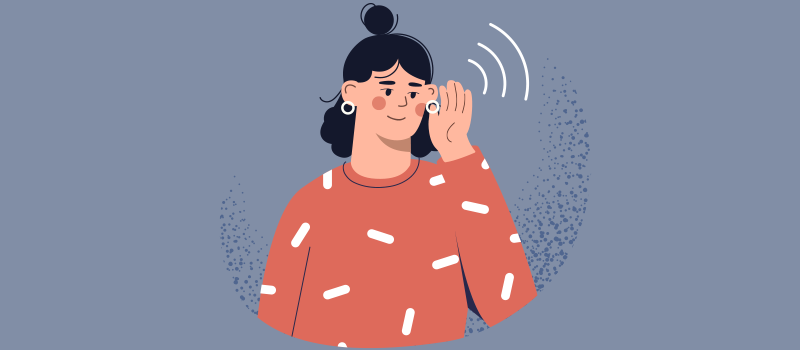What’s the Buzz
The Bee Healthy Blog
What Are the Different Types of Hearing Loss?

One in eight people in the United States, or approximately 30 million Americans over the age of 12 years, have hearing loss. A common cause is age-related hearing loss, which is also called presbycusis. Only 2% of adults aged 45 to 54 have hearing loss. But 25% of adults aged 65 to 74 and 50% of adults aged 75 and above have disabling hearing loss.
However, hearing loss in adults can also occur due to other causes such as exposure to loud sounds, head injuries, hereditary factors, side effects of prescription drugs, and health conditions like infections and high blood pressure.
Please continue reading to learn about the different types of hearing loss and how they are treated.
What are the types of hearing loss?
Hearing loss can affect people of all ages. As mentioned, it can occur due to several different reasons. Here is some brief information about the main types of hearing loss.
Sensorineural Hearing Loss
Sensorineural is the most common type of hearing loss. It occurs when the auditory nerve (hearing nerve) or cochlea in the inner ear is damaged. Sensorineural hearing loss can be an inherited condition. It can also be a noise-induced hearing loss (from prolonged exposure to loud noises). Other causes include age-related changes, certain diseases, ototoxic drugs, and injuries that can cause ear damage and lead to sensorineural hearing loss.
Sensorineural hearing loss is usually a permanent hearing loss. It is not usually treatable with medicines or surgery. However, many people with sensorineural hearing loss find hearing aids beneficial. Cochlear implants may be another treatment option.
Keep in mind that sudden hearing loss, which occurs over a period of a few days, should be evaluated without delay by an otologist (specialist in diseases of the ear). It may be a temporary hearing loss that can be treated with medications.
Conductive Hearing Loss
Conductive is a type of hearing loss that happens when sound vibrations cannot pass from the outer ear or middle ear to the inner ear. It can occur because sound waves are blocked by a foreign object, abnormal growths, or earwax in the outer ear. It can also occur due to fluid in the middle ear. Other causes include a tympanic membrane or ear drum injury, ear infection, or abnormalities of the middle ear bones. This type of hearing loss frequently occurs in children who have recurrent infections or foreign objects in the ear canal. It can affect one ear or both ears.
A hearing specialist may be able to reverse conductive hearing loss with medical or surgical treatments by repairing structural abnormalities or removing blockages. Other treatments may include a hearing aid, cochlear implant, or bone-anchoring hearing aid (BAHA).
Mixed Hearing Loss
Some people lose hearing due to a combination of sensorineural and conductive hearing loss. It is called mixed hearing loss. This usually occurs when sensorineural hearing loss is already present, and a conductive component develops in addition. Mixed hearing loss affects the inner ear, middle ear, and outer ear. It can cause more profound hearing loss. Treatment for mixed hearing loss depends on the cause and severity. Options may include surgical procedures, hearing aids, and cochlear implants.
Auditory Neuropathy Spectrum Disorder (ANSD)
ANSD hearing loss occurs due to a problem in sound transmission to the brain. It can occur due to damage to the hair cells in the inner ear. Hair cells are required to properly transmit sound information to the brain. In some people, a genetic mutation can cause ANSD hearing loss. Damage to the auditory nerve can also cause this problem.
People with auditory neuropathy spectrum disorder may have a normal hearing test but often struggle to understand speech sounds. Treatment options may include a hearing aid, cochlear implant, hearing-assistive technology (HAT), sign language, or picture exchange communication system (PECS).
What's the difference between conductive and sensorineural hearing loss?
Sensorineural hearing loss occurs due to damage to the structures in the inner ear. It is treated with a hearing aid or cochlear implant.
Conductive hearing loss occurs when a blockage in the external ear or middle ear prevents sound waves from passing through the ear canal to the inner ear. It is treated with medicines or surgery.
What are the 6 levels of hearing loss?
People with normal hearing can detect sounds at -10 to 15 decibels (dB). Doctors classify hearing loss into 6 levels based on severity:
- Slight: 16 to 25 dB
- Mild: 26 to 40 dB
- Moderate: 41 to 55 dB
- Moderately Severe: 56 to 70 dB
- Severe: 71 to 90 dB
- Profound: 91 dB and above
This means you have mild hearing loss if sounds need to be at least 30 dB for you to hear them. You have severe hearing loss if sounds have to be closer to 70 dB for you to hear them.
Sounds of 70 dB or below are generally considered safe. Long-term exposure to high-pitched sounds and loud background noise exposure to 75 dB and above can lead to hearing loss. To give you an idea, here are some examples of soft and loud noise:
- Whisper: 30 dB
- Quiet room: 40 dB
- Typical conversation: 60 dB
- Vacuum cleaner: 70 dB
- Noisy environments like a rock concert or subway: 90 dB
Get a baseline hearing test
Most people receive a hearing test in grade school and then not again until they are older adults experiencing hearing problems. However, as mentioned above, changes related to the normal aging process can affect how you process sound information over time. This can lead to age-related hearing loss and other communication disorders.
Therefore, it is a good idea to get your hearing checked once a year during your annual physical examination. The results of this hearing test can serve as a baseline. If you experience a gradual or sudden loss of hearing, your doctor can compare your current hearing to this baseline and determine the severity of your hearing loss.
Hearing tests are also vital to find out what type of hearing loss you are experiencing and decide on the appropriate treatment accordingly.
References:







SOCIAL